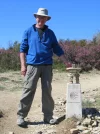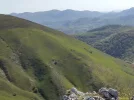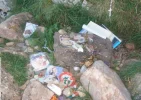I had never thought stacking cairns could be a problem.
http://www.centredaily.com/sports/outdoors/article86051077.html
http://www.centredaily.com/sports/outdoors/article86051077.html
| Remove ads on the forum by becoming a donating member. More here. |
|---|
Good point. Although I was moved and respectful of the small memorial cairns, I didn't make any memorials myself or carry a stone to Cruz De Ferro. Maybe the marks were all left on me, I didn't feel the need to leave any. I took a lot of photos, though. Maybe that's my way as an artist - to bear witness.There is a world of difference between 'ornamental' rock-piling and cairns placed as way-marks. If any wilderness fan knocked down the route markers on Cairn Gorm or Glen Shee then they might just might have a dead walker or two on their conscience. This was discussed in part in this earlier thread www.caminodesantiago.me/community/threads/is-this-true.26343/
I don't think we are talking about route markers here.There is a world of difference between 'ornamental' rock-piling and cairns placed as way-marks. If any wilderness fan knocked down the route markers on Cairn Gorm or Glen Shee then they might just might have a dead walker or two on their conscience. This was discussed in part in this earlier thread www.caminodesantiago.me/community/threads/is-this-true.26343/
But Nature does care,that's what the article featured in the link provided by the OP is about.Nature doesn't care one way or another.
You are quite right @marbuck, the OP is about the decorators, ornamenters, quasi-graffitists who seek to amend the natural environment for their own (selfish?) pleasure. My comment was intended to emphasise that not all piles of rocks are just piles of rocks. There is a small cairn in my garden, one stone for each of my tribe that has passed - my tribe being that affiliation of family, friends and foes that touched my life. Its also a way-marker, it marks the way to the life beyond all our understanding. It will be knocked down one day when I set out on further roads. Tired old man that I am I must admit to a wry smile that the author of the cited article was mainly upset that his photographs were spoiled - perhaps he should see what the M27 did to the woods I was raised in.I don't think we are talking about route markers here.
There is a world of difference between 'ornamental' rock-piling and cairns placed as way-marks. If any wilderness fan knocked down the route markers on Cairn Gorm or Glen Shee then they might just might have a dead walker or two on their conscience. This was discussed in part in this earlier thread www.caminodesantiago.me/community/threads/is-this-true.26343/
There is a small cairn in my garden, one stone for each of my tribe that has passed - my tribe being that affiliation of family, friends and foes that touched my life. Its also a way-marker, it marks the way to the life beyond all our understanding.
I spent yesterday at the funeral rites of another old friend and placed a stone this morning. You are not borrowing from me you are joining a thread that runs through all those piles of stone back to when that was all we had. Stone and aspiration and hope. And your are welcome Pilgrim.
Agree fully with you on fraking, but that is for another forum.Pilgrims who stack some rocks along the trail are doing a lot less damage than pilgrims (or just regular people) who leave a trail of litter, or set up tents in standing crops, or make cute smiley faces on the sunflowers, or even have a wee behind a tree.
cute smiley faces on the sunflowers
There's desecration and there's desecration. Both of these count in my book--one because it damages someone's personal livelihood and another because it's a symptom of a bigger problem that potentially damages air, climate, and our global livelihood.perhaps he should see what the M27 did to the woods I was raised in.
And one mostly best kept to ourselves, alas. But who can resist? Not me. Spouting off is perversely enjoyable.Deciding if someone else's camino or cairn or graffito is selfish or juvenile, "witty" or legitimate is, apparently, another deeply human ritual.
Rebekah, sorry, but could not disagree more.Making a pilgrimage is a deeply human ritual. Stacking stones as an expression of passing presence is a deeply human ritual.
Deciding if someone else's camino or cairn or graffito is selfish or juvenile, "witty" or legitimate is, apparently, another deeply human ritual.
Especially Rebekah and the Ditch Pigs she hosts each year, who no doubt clean up a ton of such pilgrim detritus.blessings on the pilgrims who walk behind and clean it up.
The Inuit people in Northern Canada build the most elegant cairns/markers called Inuksuit out of loose stones. There aren't many stones up there and the weather is brutal, so these small way markers have to be rebuilt frequently over extremely long periods of time. But only a few chosen elders are allowed to rebuild them. Some resemble human figures, some seem like doorways or windows. They seem sacred, are fragile, save lives and yet are transient like life itself.
The Artist Andy Goldsworthy creates very short-lived sculptures out in nature using materials like ice, leaves, delicately balanced stones. Some sculptures are assembled deliberately along a tidal area where they will only survive for a few hours. Some of these works collapse repeatedly while he creates them. These sculptures survive only as the photographs he makes. Life and beauty are fragile and nature takes back.
I've taken many photos of the countless Camino memorials. Most are very small. All are vulnerable - just a few delicately balanced stones, prey to wind and rain. They seem built not to last, there are sometimes fading photographs and small notes. The huge mound at Cruz De Ferro is apparently bulldozed or "tidied up" quite often.
I'd say most people who walk The Camino, often meditate about impermanence.
The solidity of stone is illusory.

Some people might remember the Olympic logo, but if they did they probably wouldn't have known what it was. I have to say that guy (the shorter one) in the photo is a real attention grabber!Inookshuk - sort of like this?:
View attachment 27493
From 2013. Found a strange new marker with no stones on it so added this.....didn't last long......asked a fellow who arrived at the albergue later that evening if he had seen it. He said: "You mean that Buddhist thing? Yeah, I saw it and knocked it down!" People get testy about these things!
Or a plastic bottle, a candy wrapper, underpants, shoes, boots, a ribbon, a photo, and a Coke can.I hope that if I get to The Last Roundup before Tincatinker, he'll put a stone on the cairn for me.
So long as it doesn't get out of hand is there really any harm?
Fascinating. Have a look at the OP!Well, it would seem it is getting out of hand, and not just on the camino:
http://www.centredaily.com/sports/outdoors/article86051077.html
But isn't the problem the fact that you don't know, at the time, which is the correct direction! You would have to walk back. On the other hand, you would be leaving a trail of breadcrumbs so that YOU will be found!I shall pile up a cairn or two to tell lost travelers where to go next.
But isn't the problem the fact that you don't know, at the time, which is the correct direction! You would have to walk back. On the other hand, you would be leaving a trail of breadcrumbs so that YOU will be found!
I was thinking I'd have to make the same mistake several times before I'd remember the next time! However, two days of searching would probably burn it into my memory.@C clearly:
But my post says that: "If I am ever back in that area, I shall pile up a cairn or two to tell lost travelers where to go next." A cairn or two usefully placed would have saved me two days of searching. I later spoke to someone in the trail office about getting a formal park sign placed where it would direct other travelers across the river and onto the vestigial path on the other side. But I rather like the idea of cairns, as they put the responsibility on the traveler, who does not have to wait for the authorities to act.
Can I take my tongue out of my cheek now?Well, it would seem it is getting out of hand, and not just on the camino:
http://www.centredaily.com/sports/outdoors/article86051077.html
In the Galician language we have two different words for this subject. "Fito" is a pile of stone to mark a way whereas "Milladoiro" is a pile of stones where people leave a stone at special/sacred places like Cruz de Ferro or San Andrés de Teixido. From this thread what I see is that there aren´t two different words in English Is that true?
The Inuit people in Northern Canada build the most elegant cairns/markers called Inuksuit out of loose stones. There aren't many stones up there and the weather is brutal, so these small way markers have to be rebuilt frequently over extremely long periods of time. But only a few chosen elders are allowed to rebuild them. Some resemble human figures, some seem like doorways or windows. They seem sacred, are fragile, save lives and yet are transient like life itself.
The Artist Andy Goldsworthy creates very short-lived sculptures out in nature using materials like ice, leaves, delicately balanced stones. Some sculptures are assembled deliberately along a tidal area where they will only survive for a few hours. Some of these works collapse repeatedly while he creates them. These sculptures survive only as the photographs he makes. Life and beauty are fragile and nature takes back.
I've taken many photos of the countless Camino memorials. Most are very small. All are vulnerable - just a few delicately balanced stones, prey to wind and rain. They seem built not to last, there are sometimes fading photographs and small notes. The huge mound at Cruz De Ferro is apparently bulldozed or "tidied up" quite often.
I'd say most people who walk The Camino, often meditate about impermanence.
The solidity of stone is illusory.
The nearest I might get to it would be tumul, (english tumulus/i) as a word for a grave marker or memorial though not in current usage so far as I'm aware. Perhaps also tum, and by extrapolation tomb. Most often, in conversation, reference is simply to the stones, or his stones. Cairn seems to have been adopted into English as the word for a pile of stones that is in one way or another of greater significance than a mere pile of stones.
I wish I could like this a million times.Rebekah, sorry, but could not disagree more.
There are brand new, lovely concrete markers, installed in the past two years between Sarria and Santiago.
Already the egotistical turistas have magic-markered them, stolen the brass mileage plates, and left empty bottles, cigarette wrappers, rocks, socks, bras, boxer shorts, cheap tennis shoes, and flowers stolen from residents' gardens as their "personal rituals."
Leaving rocks is NOT the same as a cairn. Leaving rocks and other detritus screams, IT'S ALL ABOUT ME.
Tourists leave their crap and "ritual" garbage behind.
Pilgrims leave nothing but footprints behind.
In the wilderness, a cairn is left to help others.
On the Camino, a rock is left as self-memorialization.
Shame on those who have left the Camino a messier place, and blessings on the pilgrims who walk behind and clean it up.
I think wilderness is different to cultural landscapes though. I personally love all the cultural pilgrim made artefacts on the Camino.
I'm not sure if any. R actually stops to read some of the messages/notes left by Pilgrims as they pass these pikes of stones. Not too far out of Orisson, I stopped to have a look at dome of the notes and was so touched by those in the English language. (Rest are French and Spanish) The pain and heartache in those notes brought tears to my eyes: children who died so young, spouses and hard relationships etc. I really don't see any harm in the cairns. They don't get too large after all. I think we should be concentrating more on the debris left behind by Pilgrims. There's a small town way before Arzua which has posters showing the litter left by Pilgrims. I actually cringed though I had not dropped even a tissue on Camino for the full 30 days I was on the Way.So long as it doesn't get out of hand is there really any harm?
View attachment 27529
Personally all my energy goes into my legs!
***I'm not sure if anyone actually stops to read some of the messages/notes left by Pilgrims as they pass these piles of stones. Not too far out of Orisson, I stopped to have a look at some of the notes and was so touched by those in the English language. (Rest are French and Spanish) The pain and heartache in those notes brought tears to my eyes: children who died so young, spouses and hard relationships etc. I really don't see any harm in the cairns. They don't get too large after all. I think we should be concentrating more on the debris left behind by Pilgrims. There's a small town way before Arzua which has posters showing the litter left by Pilgrims. I actually cringed seeing that, though I had not dropped even a tissue on Camino for the full 30 days I was on the Way.
I did not see any of these superfluous stacked stones between SJPP and Roncesvalles but maybe that has changed now, too. What I did see, is the habit of leaving stuff of the kind you describe next to anything that looks remotely religious, in particular the Virgin of Biakorri and the Thibault cross. At first I thought it was a local tradition but then I realised it was what passing-through camino walkers leave behind. I often wonder how many of them know or care why the statue or the cross are there and why they feel the need to add something artificial to this part of what's left of our natural landscapes:Not too far out of Orisson, I stopped to have a look at some of the notes and was so touched by those in the English language. (Rest are French and Spanish) The pain and heartache in those notes brought tears to my eyes: children who died so young, spouses and hard relationships etc. I really don't see any harm in the cairns.


Some of my fellow pilgrims were very surprised I had not added even a single stone to any of the piles already in existence, really too tired and feel for sure I would have fallen over trying to pick up a pebble, especially when I had no idea why I should do so. I did stop to read notes, though. Ha ha, probably taking a break!!I, like Jeff, use all my energy on the Caminos walking with my legs. I am just plain too tired to even think of bending over to pick up a rock!
I have also come across some cairns(actually pointed out by our guide) while on the Drakensberg, South Africa. These apparently put in place by Bushmen as grave markers.A retired bomb disposal officer told me that in certain countries a pile of stacked stones can be an indicator of nearby roadside mines/IEDs. Not an issue for Spanish camino routes, I completely accept, but it offers another quite stark example of the practical importance some of these structures can have for human survival.


